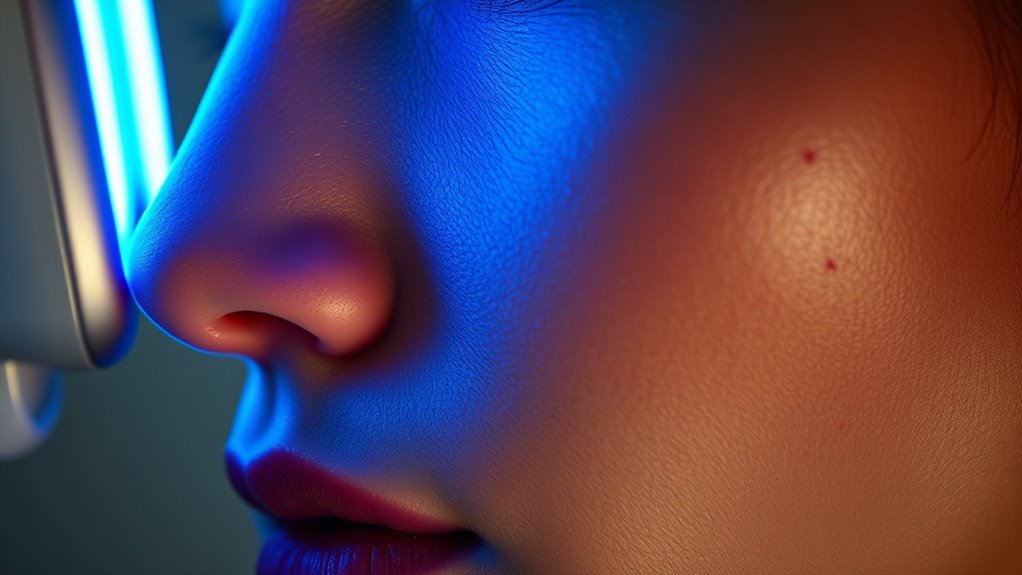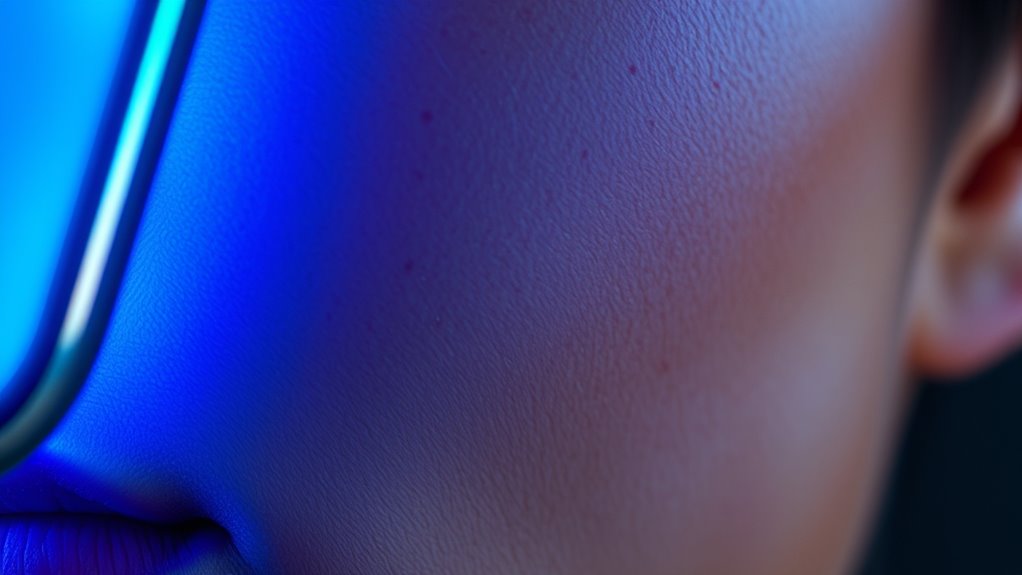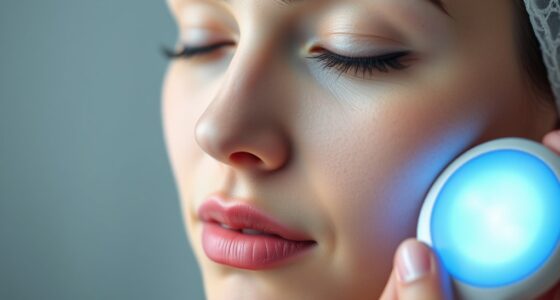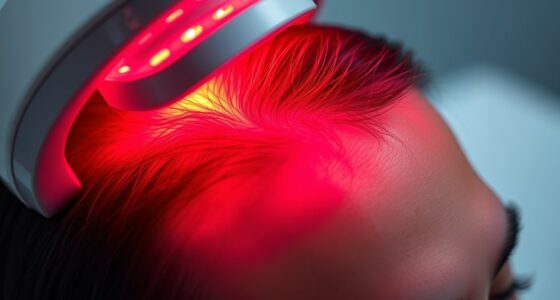Blue light from screens can contribute to hyperpigmentation and accelerate skin aging over time, even though it’s less intense than UV rays. It penetrates deeper into your skin, triggering inflammation and excess melanin production that leads to dark spots and uneven tone. If you spend a lot of time on devices, your skin is more vulnerable. To better understand how to protect your skin and the effective options available, keep exploring further.
Key Takeaways
- Blue light penetrates deep skin layers, stimulating melanin production and potentially worsening hyperpigmentation over time.
- Unlike UV rays, blue light does not cause sunburn but still induces oxidative stress and cellular damage.
- Prolonged screen exposure increases blue light contact, raising the risk of pigmentation issues, especially with existing hyperpigmentation.
- Protective skincare with antioxidants and blue light filters can help mitigate blue light–induced skin damage.
- Current evidence suggests blue light is more of a foe than a friend for hyperpigmentation, requiring proactive protection.

Many people are unaware that blue light from screens and digital devices can contribute to skin issues like hyperpigmentation. As you spend more time on your phone, computer, or tablet, you’re exposing your skin to this high-energy visible light, which can penetrate deep into the layers of your skin. This exposure can stimulate the production of melanin, the pigment responsible for skin color, leading to dark spots or uneven skin tone over time. While blue light’s effects are less understood than those of UV rays, emerging research suggests it might play a significant role in skin aging and pigmentation changes.
You might think that only sunlight impacts your skin’s health, but blue light is a different beast. Unlike UV rays, blue light doesn’t cause sunburn, but it can still induce oxidative stress within your skin cells. This stress damages cellular structures and can trigger an inflammatory response, which in turn stimulates melanocytes—the cells responsible for melanin production. When these cells are overactivated, they produce excess pigment, leading to hyperpigmentation. If you’re already dealing with dark spots or uneven skin tone, prolonged exposure to blue light could worsen these issues.
Blue light can cause oxidative stress and worsen hyperpigmentation, even without sunburn.
Your daily habits matter more than you realize. For example, if you work long hours at a computer or binge-watch late into the night, you’re increasing your skin’s exposure to blue light. Even if you’re diligent about applying sunscreen, remember that most sunscreens primarily block UV rays and don’t offer protection against blue light. This means your skin remains vulnerable during extended screen time. Additionally, the blue light emitted from screens is less intense than sunlight, but because the exposure is often prolonged and close to your face, the cumulative effect can be significant.
Thankfully, you can take steps to protect your skin from blue light’s potential harm. Incorporating skincare products with antioxidants like vitamin C and niacinamide helps neutralize free radicals generated by blue light exposure. Wearing blue light filters or glasses during long screen sessions creates a physical barrier, reducing the amount of blue light reaching your skin. You might also consider using skincare with ingredients that support skin barrier health, such as ceramides, to bolster your skin’s defenses. If hyperpigmentation is a concern, consult a dermatologist about treatments tailored to diminish dark spots and prevent new ones from forming.
Being aware of blue light’s penetrative capacity can further motivate you to adopt protective measures, as it highlights how this light reaches deeper skin layers than some other wavelengths. In the end, understanding blue light’s impact on your skin empowers you to make informed choices. While it’s not the sole cause of hyperpigmentation, it’s a factor worth considering as part of your overall skincare routine. By taking proactive steps, you can enjoy your digital devices without compromising your skin’s health.
Frequently Asked Questions
Can Blue Light Cause Immediate Skin Reactions or Only Long-Term Damage?
Blue light generally doesn’t cause immediate skin reactions like redness or irritation. Instead, its effects tend to develop over time, potentially leading to long-term skin damage and hyperpigmentation with prolonged exposure. You might not notice instant changes after brief exposure, but consistent exposure could contribute to skin aging and pigmentation issues. It’s wise to protect your skin if you’re often exposed to blue light, especially from screens and digital devices.
Are Certain Skin Types More Susceptible to Blue Light-Induced Hyperpigmentation?
Think of your skin as a delicate canvas; some tones are more prone to blue light’s subtle brushstrokes of hyperpigmentation. Fairer skin often acts like a blank sheet, showing damage more clearly, while darker skin tones may hide these signs better. If your skin is sensitive or prone to discoloration, you’re more likely to be affected. So, yes, certain skin types are more susceptible to blue light’s long-term effects.
Do Common Skincare Ingredients Effectively Protect Against Blue Light?
Yes, many common skincare ingredients can protect against blue light. Ingredients like antioxidants, niacinamide, and vitamins C and E neutralize free radicals generated by blue light exposure. Look for products containing these ingredients to strengthen your skin’s defenses. Regular use of broad-spectrum sunscreens with mineral filters like zinc oxide or titanium dioxide also helps block blue light. Incorporate these into your routine to help prevent potential damage and hyperpigmentation.
How Does Blue Light Exposure Compare to UVA and UVB in Skin Damage?
You should know blue light can penetrate deeper into your skin than UVA and UVB rays, which only affect surface layers. While UV rays are responsible for 90% of skin aging and damage, blue light contributes to long-term skin concerns like hyperpigmentation and oxidative stress. So, blue light exposure can be just as damaging over time, especially with prolonged screen use, making protection essential for your skin’s health.
Are There Specific Dietary Habits That Influence Blue Light’s Effects on Skin?
You can influence blue light’s effects on your skin through your diet. Incorporate foods rich in antioxidants, like berries, nuts, and leafy greens, to help protect your skin from oxidative stress caused by blue light. Avoid excessive sugar and processed foods, which can promote inflammation. Staying hydrated and eating a balanced diet supports your skin’s resilience, reducing potential damage from blue light exposure.
Conclusion
As you navigate the glow of blue light, remember it’s a double-edged sword—like sunlight filtering through a thin veil, it can both illuminate and cast shadows on your skin. While it’s a friend in keeping you connected, it’s also a foe lurking behind the scenes, whispering promises of hyperpigmentation. Protect your skin like shielding a precious treasure, and let your skincare routine be the fortress that keeps the damage at bay.









